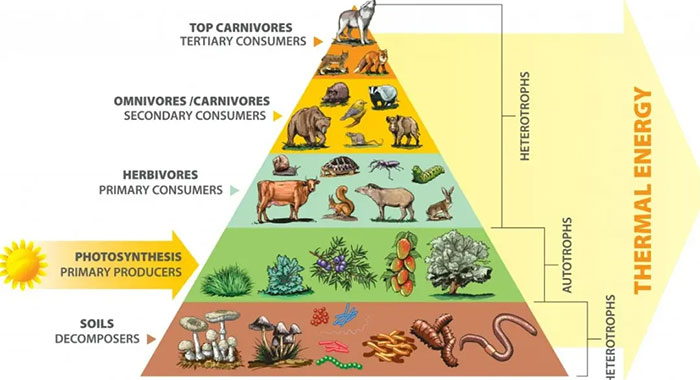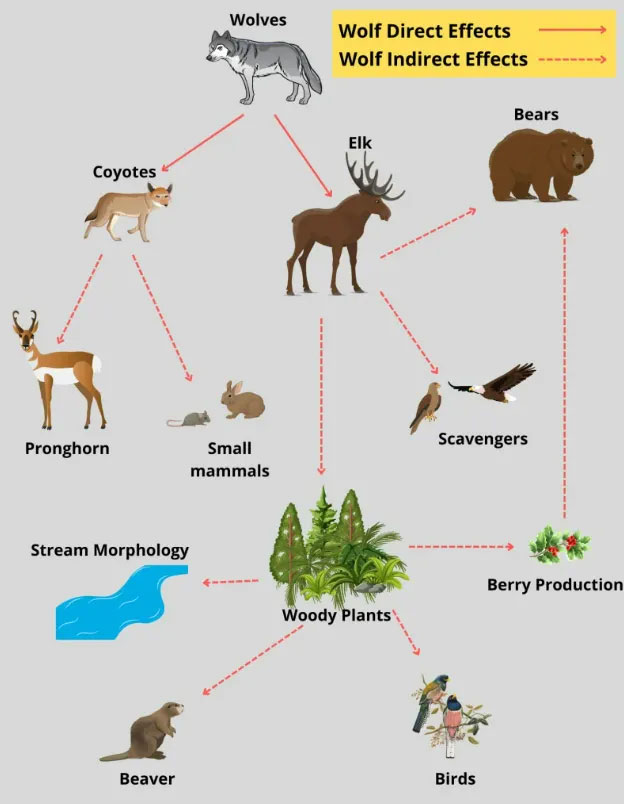In the 1920s, wolves disappeared from Yellowstone National Park. Nearly a century later, the rivers changed their courses. What happened?
We have learned in school about the food chain and nutrient cascade phenomena. While you may memorize their definitions, you will never truly understand the real-time consequences on the food web in real life.
A fascinating cascade with altered flow has been observed in Yellowstone National Park, USA. In the mid-1920s, an effort to exterminate wolves in the park (and across the United States) led to changes in the rivers’ courses within the park. The connection is intriguing because wolves, as terrestrial predators, do not have a direct relationship with rivers. So what transpired here?
The food chain and order consist of living organisms that depend on each other for food and energy. Therefore, disrupting the food chain can lead to a hypothesized change in the nutrient cascade. It takes time for a new nutrient level to form, but a clear case is what happened in Yellowstone National Park. Due to the extermination of gray wolves—the apex predator in the food chain—species at lower levels became uncontrollable, leading to population explosions and overuse of natural resources. The disaster from this unplanned displacement took about seven decades to identify.

Ecological food chain.
The wolf extermination program began in the mid-1920s in response to farmers’ concerns about the safety of their livestock. Wolves were one of the park’s top predators, primarily preying on elk.
Due to the extinction of wolves, the predation pressure on elk decreased, and their population began to thrive, peaking within a few decades. The increase in herbivore numbers stressed the vegetation, resulting in the depletion of grass and young trees in the park. The loss of riverbank grasslands and young trees was particularly evident, as elk had both food and drinking water sources near the riverbanks. Populations of other species also declined due to a lack of available food resources.
The park also had a thriving beaver population. Beavers consume the rich nutrients found in the new shoots of trees. However, with overgrazing by elk, the foliage around the rivers thinned, causing beavers to migrate from the riverbanks to other areas. Along with them came one of nature’s greatest engineering wonders—the beaver dam. The water retention ability of these beaver dams saturated the nearby soil, ensuring a stable moisture supply for plants, even in the absence of rain…
The disappearance of vegetation and beaver dams near the riverbanks inevitably led to soil erosion in the area. Seasonal floods began, causing the rivers to meander differently than their original courses. These changes in the rivers disrupted groundwater levels and affected the growth of vegetation in nearby areas. It also impacted the movement patterns of species from one side of the river to the other.
Thus, a long story began with the disappearance of one species from the top of the food chain, affecting every link in various ways, including the increase in elk populations, the decline in biodiversity, the destruction of beaver habitats, and ultimately the alteration of river flows.

Direct and indirect impacts of wolf extermination
Shortly after scientists discovered this tropical cascade in the natural system, 41 wolves were reintroduced to Yellowstone National Park after nearly 70 years of absence. The wolves began hunting the densely populated elk, and elk gradually avoided open areas, such as riverbanks, for fear of being hunted. As a result, overgrazing near the riverbanks ceased, allowing new saplings to grow.
The beavers also returned, constructing complex dams and providing ample cover for smaller rodent species. The rate of soil erosion slowed, and the rivers began to retrace their original paths. As a result of reintroducing apex predators into the food chain, the entire ecosystem was restored.
All of this implies that if we view wolves as a species to be exterminated and replace them with elk, would that be better for the ecosystem? Clearly not. Here, it is essential to emphasize that we still need to protect species, but interfering with a stable ecosystem can be a mistaken endeavor.
Wolves can also be part of an important story. They are flexible predators, hunting beavers and other animals that live and thrive on riverbank vegetation. However, too many predators, such as wolves, can also alter the flow of rivers.
The processes of nature are inherently complex and result from many interactions between various biotic and abiotic factors. Scientists are still searching for other variables that could help restore the original form of the Yellowstone National Park ecosystem. They also acknowledge that there is still much to understand about the factors causing changes in the park’s surrounding environment, and there is still much research to be done.


















































